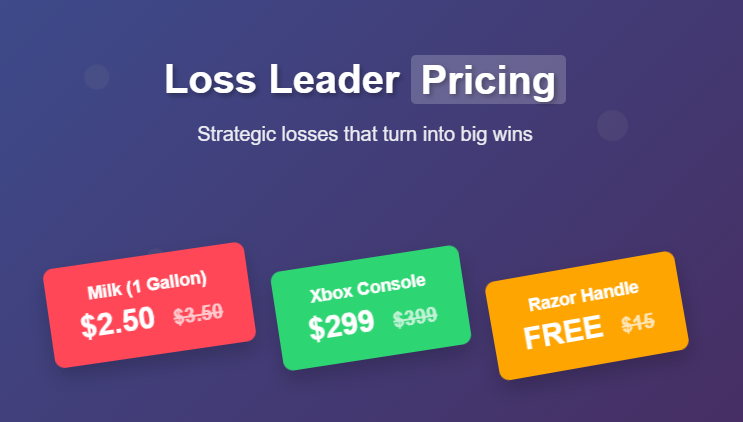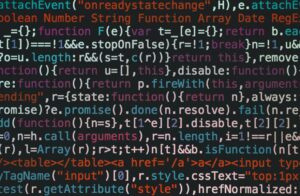
You walk into Walmart for milk. It’s priced at $2.50. That’s below what it costs them to buy and stock it. But you also grab bread, cereal, and maybe some snacks. Your $3 milk run becomes a $25 shopping trip.
That’s loss leader pricing in action.
What Does Loss Leader Mean?
A loss leader strategy involves selling a product or service at a price that is not profitable but is sold to attract new customers or to sell additional products and services to those customers. The business takes a hit on one item to make money elsewhere.
Think of it as strategic losing to win big.
The loss leader definition is simple. Companies deliberately sell certain products below cost. They’re willing to lose money on these items because they expect customers to buy other, more profitable products during the same shopping trip.
This isn’t desperation pricing. It’s calculated strategy.
How Loss Leader Pricing Works
Loss leader strategies only start to make sense when you consider them in terms of customer lifetime value (CLTV, or LTV). The goal isn’t making money on individual transactions. It’s about the total value customers bring over time.
Here’s the psychology: People love deals. When they see an amazing price on something they need, they feel compelled to take advantage. Once they’re in your store (physical or digital), you have opportunities to sell them additional items at normal profit margins.
The hope is that once the shopper buys the product from the store or the website, the shopper will buy other products and become loyal to the brand.
What Companies Use Loss Leader Pricing?
Several major companies have built their business models around loss leader strategies.
Gillette made this famous with razors. Gillette, for example, often gives their razor units away for free or at a low price, knowing that customers must buy replacement blades, which is where the company makes its profit. The razor might lose money, but those replacement blades are highly profitable.
Microsoft used loss leaders with Xbox consoles. The product was sold at a low margin per unit, but Microsoft knew that there was potential to profit from the sale of video games with higher margins and subscriptions to the company’s Xbox Live service.
Walmart prices many everyday essentials below cost. They know people need milk, bread, and basic groceries. These loss leaders bring customers in. Then those customers buy higher-margin items like electronics, clothing, or pharmacy products.
Amazon frequently sells products below cost, especially during Prime Day or holiday sales. They make up losses through other purchases and Prime memberships.
Grocery stores universally use this strategy. Milk, a common household item, is often placed at the back of every grocery store, requiring an individual to pass by almost every other item in a grocery store. The placement is intentional.
Types of Loss Leader Strategies
There are several ways companies implement loss leader pricing.
Free trials work as service-based loss leaders. A free trial gives potential customers the chance to try out your product risk-free. By offering your services for up to a month free of charge, you don’t earn while you’re fulfilling those services. But converting even a small percentage of trial users makes it profitable.
Convenience buys target everyday necessities. These are items people need regularly and will specifically shop for. Bread, milk, gas, and basic household supplies fall into this category.
Upsell opportunities involve pricing the main item cheap but making money on add-ons. When you buy a burger and fries, you’re attracted to the main item. An attractively priced burger is hard to turn down. Often, restaurants turn minimal to negative profits on such items. But the fries? Those are very expensive relative to their cost.
Promotional pricing uses temporary discounts to bring in new customers. Black Friday sales often put items into loss leader territory. The goal is acquiring customers who’ll return at full prices.
Benefits of Loss Leader Pricing
Loss leader pricing can draw in customers who may not otherwise be aware of your brand. It’s particularly effective for businesses entering new markets or competing against established players.
The strategy increases overall sales volume. While you lose money on specific items, total basket size typically grows. Customers feel they’re getting value, which encourages additional purchases.
If customers have a positive experience with a loss leader, they’ll often come back to buy more products or services at full price. You’re not just making a sale; you’re potentially gaining a long-term customer.
Loss leaders also help clear inventory. If you have excess stock or seasonal items, pricing them as loss leaders moves products while bringing in foot traffic.
Risks and Downsides
The greatest risk is that clients may only take advantage of the loss leader pricing and not use any of the business’s other products and services. This behavior is called cherry picking.
Some customers become deal-dependent. They only shop your store for discounted items and never pay full price for anything. These customers cost you money rather than generating profit.
There’s been a major debate around whether loss leader pricing is ethical. In Ireland, the use of loss leader pricing is banned. Businesses cannot sell products/services lower than their cost. Some regions restrict this practice because it can hurt small businesses unable to absorb losses.
Brand perception can suffer if overdone. Constant discounting may make customers view your products as cheap or low-quality.
When Loss Leader Pricing Makes Sense
This strategy works best for businesses with diverse product lines and healthy margins on complementary items. You need other profitable products to offset the losses.
If you want to use loss leader pricing, you’ll need to be able to afford the initial loss. For businesses with robust margins in other areas, such as those offering high-margin accessories or extended warranties, this strategy can be a game-changer.
Consider your customer’s buying patterns. Do they make multiple purchases, or are there opportunities to upsell? Loss leaders work best in businesses where you can increase customer lifetime value (CLV) through repeat purchases.
Physical retail locations benefit most from loss leader strategies. Strategic product placement forces customers to walk past other items, increasing impulse purchases.
Implementing Loss Leader Pricing
Start by selecting the right products. Choose items that are popular, necessary, or seasonal. They should appeal to your target customers but not represent your core profit drivers.
Set clear limits. Decide how many units you can sell at a loss and for how long. Time-limited offers create urgency while controlling your exposure.
Price it strategically: Your loss leader should be priced low enough to attract customers, but not so low that it devalues your brand or results in unsustainable losses.
Track everything. Monitor which loss leaders bring in the most customers and generate the highest additional sales. Measure customer acquisition costs and lifetime value to ensure the strategy is profitable overall.
Making It Work for Your Business
Loss leader pricing isn’t right for every business. It requires careful planning, diverse inventory, and the financial capacity to absorb short-term losses.
But when executed properly, it’s incredibly effective for building customer bases and increasing sales volume. The key is ensuring that loss leader customers convert to profitable, long-term relationships.
Test small before going big. Try loss leader pricing on select items during slow periods. Measure the results. If customers buy additional items and return for future purchases, you’ve found a winning strategy.




